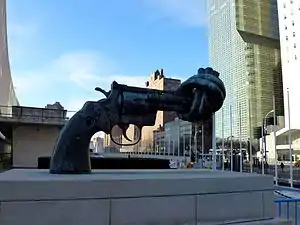Humanium Metal
Humanium Metal is a brand of metal made by melting down illegal firearms seized in conflict zones. The creation and distribution of this metal is done through a marketing campaign called "The Humanium Metal Initiative", started in 2016 by Swedish nonprofit organization Individuell Människohjälp Swedish Development Partner. The stated objective of the campaign is to draw attention to issues of gun violence and contribute toward the ending of illegal firearms trade. Humanium Metal is used for the creation of some small ornamental objects, such as wristwatches, buttons, and spinning tops, with proceeds returning to charitable causes in the areas from which the firearms were seized.

History
The Humanium Metal Initiative was conceived of by Peter Brune of Swedish nonprofit organization Individuell Människohjälp Swedish Development Partner in partnership with designer Johan Pihl.[1] According to the website of the organization, the objective of the project is "to spread awareness of the devastating impact of illegal firearms and armed violence, as well as generate funds urgently needed to empower people living in conflict-torn societies."[2] The campaign is implemented in conjunction with Swedish advertising agencies Great Works and Akestam Holst.[3]
Humanium Metal was first produced in November 2016 in El Salvador, where firearms seized by the Salvadoran government were converted into one ton of metal.[1][4] The project has since expanded to Guatemala, and, as of 2018, it plans to expand to Honduras and Colombia.[3]
The program has received endorsements from the Dalai Lama, former director general of the International Atomic Energy Agency Hans Blix, and Nobel Peace Prize winner Desmond Tutu. The program has also partnered with the Swedish Ministry for Foreign Affairs.[3]
As of mid-2018, the program had used about 5,000 weapons to make three tons of Humanium Metal, with the organization saying that total orders for the metal amounted to US$3 million. Proceeds from the sale of Humanium Metal is sent back to local charitable organizations in the conflict zones that supplied the firearms.[3]
Production and use
The most common method for producing Humanium Metal is when governments seize illegal firearms and melt down their metal, turning it into ingots, wire, or pellets.[1] The metal is 95% iron, and ingots are then sent to Sweden, where they are reduced to powder that can be used in the production of metal objects. As of 2018, Humanium Metal was priced at about $6.60 per ounce.[5]

In 2018, Stockholm-based watchmaker TRIWA began to market wristwatches 3D-printed with Humanium Metal.[4][6] In 2019, the Humanium Metal Initiative partnered with The Non-Violence Project Foundation to produce small-scale replicas of Swedish artist Carl Fredrik Reuterswärd's 1985 sculpture Non-Violence. Other companies have begun to produce spinning tops, buttons, and bracelets made from Humanium Metal.[7] A Good Company has made a limited-edition A Good Humanium Metal pen, 25% of the sales of which goes to support projects tackling violent crime and rebuilding conflicted-afflicted communities in El Salvador. [8]
In 2020, Scottish artist Frank To created paintings using powdered Humanium Metal mixed with paint. [9]
Awards
In 2017, the Humanium Metal Initiative won the Grand Prix for Innovation at the Cannes Lions Festival for Creativity.[10] In 2018, the program won the advertising category of Fast Company's 2018 World Changing Ideas Awards.[3]
References
- Barraza, David (2016-12-09). "Program seeks to use seized guns for good in El Salvador". AP NEWS. Retrieved 2020-01-19.
- "Humanium Metal". humanium-metal.com. Retrieved 2020-01-18.
- Paynter, Ben (2018-04-09). "Humanium Is A Metal Made From Guns, To Help Stop Gun Violence". Fast Company. Retrieved 2020-01-19.
- Pangburn, D. J. (2019-01-03). "How watches made of seized guns can help rebuild El Salvador's economy". Fast Company. Retrieved 2020-01-19.
- MacBride, Elizabeth (2018-07-16). "Swedish Entrepreneurs Are Melting 10,000 Crime Guns From El Salvador To Make Watches". Forbes. Retrieved 2020-01-19.
- Kaplan, Michael (2018-06-19). "Illegal guns are being melted down into fancy watches". New York Post. Retrieved 2020-01-19.
- Paynter, Ben (2019-01-10). "They're recreating this classic anti-gun-violence sculpture with metal from melted-down guns". Fast Company. Retrieved 2020-01-19.
- "A Good Company launches "A Good Humanium Metal Pen" Project". My Green Goodiebag. Retrieved 2020-11-07.
- Fraser, Alasdair (4 November 2020). "Artist uses metal from melted down weapons to create art auctioned to help the global fight against gun violence". Ross-Shire Journal.
- Stein, Lindsay (2017-06-20). "Humanium Metal Initiative Takes Innovation Grand Prix". AdAge. Retrieved 2020-01-19.